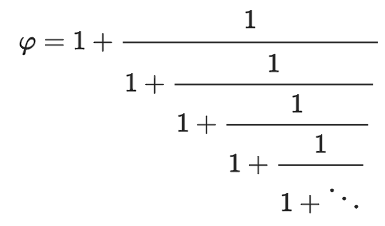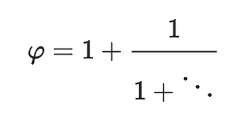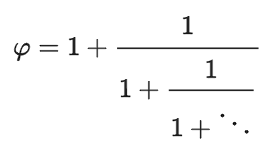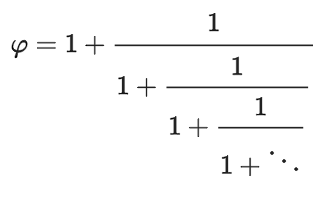17
2
In anticipation of MathJax being temporarily disabled, the rendered MathJax in this question has been replaced with images. You are still welcome to post answers but you'll have to view the rendered MathJax on another site.
PPCG just got MathJax! This means we can now easily include well formatted mathematical formulas into posts. (Handy MathJax tutorial.)
For example, here is the golden ratio expressed as an infinite continued fraction:

The MathJax code for this equation is
$$\varphi=1+\cfrac1{1+\cfrac1{1+\cfrac1{1+\cfrac1{1+\ddots}}}}$$You can find this by right clicking the formula and following Show Math As → TeX Commands.
The $$ means it is displayed on its own in the center of the page instead of inline. Use a single $ for inline.
Challenge
Write a program that takes in a non-negative integer, n, and outputs the MathJax code for that many "steps" of the continued fraction for the golden ratio.
To keep things standard across answers, you must use this exact MathJax syntax:
For n = 0, the output must be
$$\varphi=1+\dots$$.
Which is rendered as:
For n = 1, the output must be
$$\varphi=1+\cfrac1{1+\ddots}$$.
Which is rendered as:
For n = 2, the output must be
$$\varphi=1+\cfrac1{1+\cfrac1{1+\ddots}}$$.
Which is rendered as:
For n = 3, the output must be
$$\varphi=1+\cfrac1{1+\cfrac1{1+\cfrac1{1+\ddots}}}$$.
Which is rendered as:
This pattern continues on for larger n. You could say that n represents the number of division lines in the equation.
Notes
\cfracis used instead of the more common\frac.\dotsis used instead of\ddotsfor n = 0.- Take input from stdin or the command line.
- Output to stdout (with an optional trailing newline).
- Alternatively, you may write a function that takes in n as an integer and returns the MathJax code as a string (or still prints it).
Scoring
The smallest submission in bytes wins. Tiebreaker goes to the earlier submission.
Just a note to those wanting to run the stack snippet: Like many (most?) stack snippets, this doesn't work in Safari. – Alex A. – 2015-04-08T00:53:26.597
The stack snippet doesn't work when you type stuff... it gives
Uncaught ReferenceError: textbox is not defined– soktinpk – 2015-04-08T02:50:11.857@soktinpk That's strange, I'm having the same problem. But the snippet over here works even though it's the exact same... Here's an external byte counter in case.
– Calvin's Hobbies – 2015-04-08T02:57:02.683MathJax has been reenabled for PPCG! – wastl – 2018-07-10T13:53:10.977